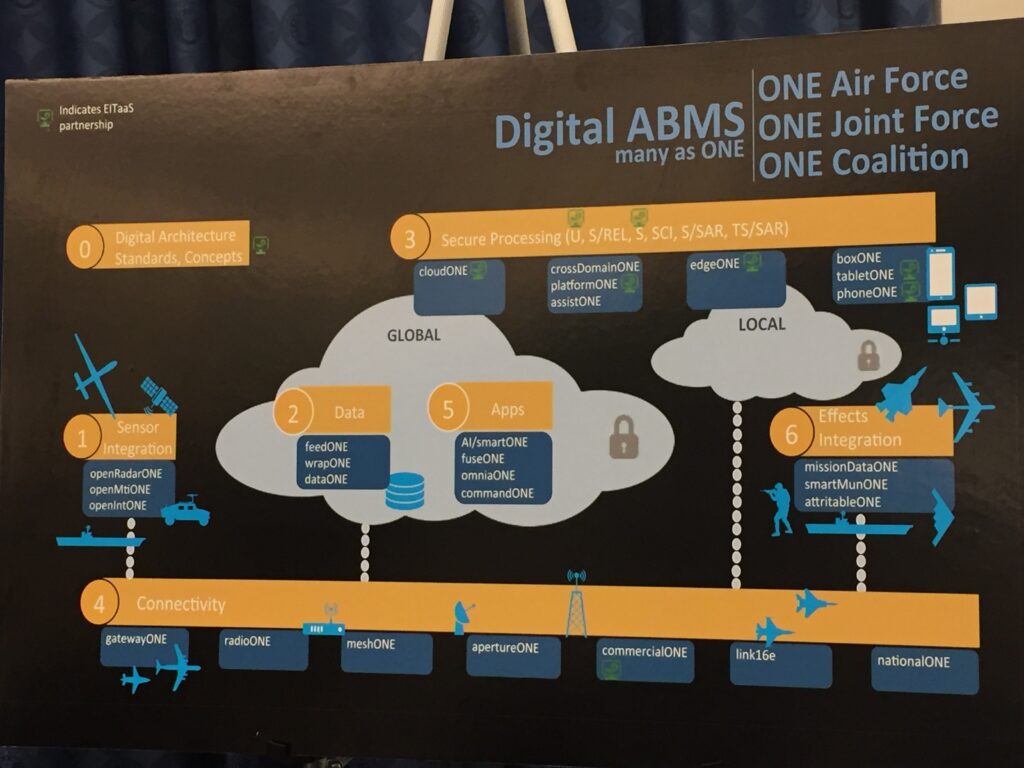Advanced Battle Management System Overview
 WASHINGTON: Keen to build support for its Advanced Battle Management System (ABMS) for command and control of future multi-domain operations, the Air Force will let combatant commands “walk away” with and field emerging technologies tested in its quarterly series of exercises, senior officials say.
WASHINGTON: Keen to build support for its Advanced Battle Management System (ABMS) for command and control of future multi-domain operations, the Air Force will let combatant commands “walk away” with and field emerging technologies tested in its quarterly series of exercises, senior officials say.
“The whole plan here is that If something is built and that warfighter says ‘I like that; I’m good with that 10 percent or 20 percent solution,’ we want to be able to let them go home with it,” Preston Dunlap, the Air Force’s Chief Architect, told reporters today in a briefing with Will Roper, the service’s acquisition chief.
Another goal of the ABMS exercises is to demonstrate how existing platforms can be upgraded to allowing them to communicate machine-to-machine with each other, sensors such as satellites and soldiers on the field. The capability to communicate in near-real time is the linchpin in DoD’s evolving concept for MDO.
Indeed, Roper said, one of the key successes of the first “ABMS OnRamp” exercise held Dec. 16-18 was demonstrating a new “gateway” — essentially a radio and antenna system put together by Lockheed Martin, Northrop Grumman and Honeywell — that allowed Navy and Air Force F-35 Joint Strike Fighters to exchange data with F-22 Raptors with a low probability of detection. As Breaking D readers know well, the F-22’s Intra-Flight Data Link (IFDL) and the F-35 Multifunction Advanced Data Link (MADL) computer languages currently are incompatible.
Will Roper (left) and Preston Dunlap (right)
 Further, the service is pushing its sister services and the combatant commands to offer new technologies they have been working on to the ABMS demonstrations, the two officials explained, so they can field new capabilities as fast as possible. As an incentive, Roper said, the ABMS program will be willing to help fund development of the systems even though they come from the Navy, Marines or Army if they commit to using ABMS products.
Further, the service is pushing its sister services and the combatant commands to offer new technologies they have been working on to the ABMS demonstrations, the two officials explained, so they can field new capabilities as fast as possible. As an incentive, Roper said, the ABMS program will be willing to help fund development of the systems even though they come from the Navy, Marines or Army if they commit to using ABMS products.
ABMS, Roper explained, is essentially the first effort by DoD to “build the Internet of Things for the military.”
The Air Force used the briefing to publicly unveil an organization chart of the ABMS family of systems. ABMS is comprised of six key technology types or “product areas,” and the 28 specific products it intends to develop over time, Dunlap and Brig. Gen. David “Kumo” Kumashiro, the key Air Force military officer involved in ABMS development, told me in an exclusive interview Dec. 13.
Each of those ABMS component parts have been labeled with the moniker ONE: such as “gatewayONE” for the radio-antenna system providing translation services between the F-22 and F-35.
For the December exercise, “gatewayONE” was on the ground but the Air Force intends to install it on a drone during the next exercise, currently planned for the first two weeks of April.
Roper said “the best option” for flying the gateway is the service’s Skyborg, being built by Kratos. “That’s the preferred carrier of choice,” he said, but “we won’t wait on Skyborg” if it’s not ready by April. Instead, the service will find another platform to carry it to keep the ABMS schedule on track, which, as Breaking D readers know, are to be held every four months.
Dunlap added that the successful demo has prompted Transportation Command to consider how it might utilize the gateway to link its various tanker aircraft.
Dunlap said that the other “successes” during the exercise were:
The Valkyrie is the only drone to have flown with the Skyborg AI wingman package — but the Air Force isn’t ruling out the eventual use of another drone.
demonstrating that an aircraft, in this case an AC-130, could link to Low Earth Orbit (LEO) communications satellites, in the case a SpaceX Starlink;
demonstrating up to secret level access to a cloud-based C2 and situational awareness application via “cloudONE” (rather than commanders being tied to a specific local computer in a building);
and, showing that connectivity between operators could be maintained outside of a “brick and mortar” command post by setting up in a tent.
Pressed by reporters, Roper explained that the Air Force eventually hopes to link cloudONE to the planned DoD-wide JEDI cloud — which is embroiled in a highly political spat between President Donald Trump and Amazon founder Jeff Bezos.
“We’re huge fans of the cloud. That’s why we have one,” Roper said. “That’s why we’ve gone ahead and worked ahead of the JEDI contract to make sure that we’re learning how to fight with both Global Cloud and Cloud at the Edge.”
“The two providers that are providing cloudONE are Amazon and Microsoft,” he added. “Microsoft is the selected performer for JEDI, so when they’re up and running, if their contract vehicle provides better rates or advantages on, we will, of course, use it.”
While today was the first time the media has seen the Air Force’s ABMS “Quick Reference Guide,” senior service officials used it to brief senior Army and Navy leaders at its annual command and control summit last week as part of its campaign to sell its sister services on the value of ABMS. Roper said he also recently briefed Capitol Hill on the ABMS concept as the Air Force pushes to convince skeptical lawmakers to pump up the budget.
The April exercise, according to the two officials, will again involve Northern Command, which served as lead for the December exercise, but will be expanded to include Space Command and Strategic Command, as well as participants from the new Space Force. However, they would not go into details regarding the scenario or systems at play.
No comments:
Post a Comment